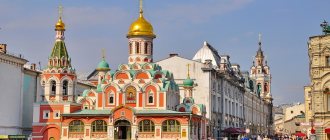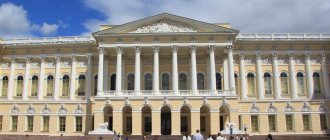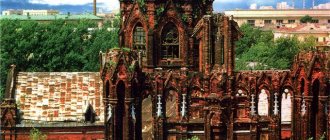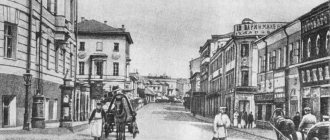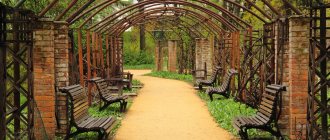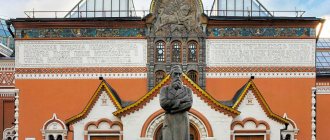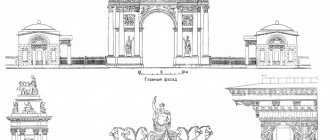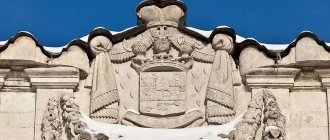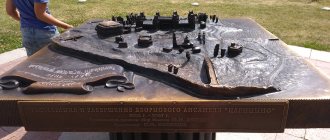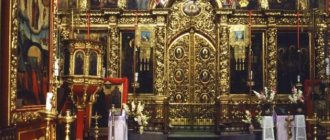History of the Kazan Cathedral in St. Petersburg
In 1710, a chapel was built on Nevsky Prospekt next to the wooden hospital building, and later the wooden Church of the Kazan Mother of God. By decree of Empress Anna Ioannovna, the new stone church was founded in September 1733, built according to the design of M. Zemtsov and was named Rodestvensky. A significant decoration of the built church was a multi-tiered bell tower 58 meters high.
On July 2, the Kazan Icon of the Mother of God was transferred here from the Trinity Cathedral. And the Nativity Church began to be called Kazan Church after the name of this icon. Later, the church received the status of a Cathedral, which became the main temple in the Northern capital.
By the end of the 18th century, the building had fallen into disrepair and a decision was made to build a new temple. Paul I wanted the new temple to be similar to St. Peter's Cathedral in Rome and in 1799 a competition was announced for its design.
Count A.S. Stroganov, whose residence was located near the temple, proposed a project by the young architect A.N. Voronikhin, his former serf. The project of Andrei Nikiforovich Voronikhin was approved. In the presence of Alexander I, a new temple was founded. Count Stroganov became responsible for the construction, which was completed by 1811. And the author of the project A.N. Voronikhin was awarded the Order of Anna, second degree, and a lifelong pension.
Only Russian craftsmen participated in the construction of the temple. The team of masons was led by Samson Sukhanov. Most of the builders were serfs, who gave all their earnings to their owners. They lived first in dugouts outside the city, and then in barracks on Konyushennaya Square. Domestic materials were used to decorate the temple: Olonets marble, Vyborg and Serdobol granite, Riga limestone. The external cladding of the walls is made of Pudozh stone, which was brought from Gatchina.
The history of the famous icon
In 1579, 27 years after Russia captured the Kazan Khanate, a large fire broke out in its capital. The fire was quickly spread by the wind, and the merciless flame destroyed part of the houses in Kazan. According to the surviving legend, it was then that the ten-year-old Matrona saw the Mother of God in a dream, and she asked her to find the icon on the ashes.
The girl hastened to tell the local priest Ermolai about the dream. When the fire was excavated, an image of the Mother of God was actually found in the indicated place. Later, a new convent was rebuilt at the site of the fire, and Matrona, taking the name Mavra, became its first novice.
Several copies or copies were made of the newly acquired image. The first of them was sent as a gift to the Russian sovereign Ivan IV the Terrible in 1579. Then icons appeared in other Russian cities. Everywhere they were preserved as shrines; separate churches were built and monasteries were founded in honor of the Kazan icons. The holiday of finding an Orthodox shrine is still celebrated by believers on July 8th.
Colonnade of the Kazan Cathedral in St. Petersburg
A.N. Voronikhin solved the main problem. Since there should be an entrance in the west of the temple and an altar in the east, the temple turned out to be sideways to Nevsky Prospekt. According to the architect's decision, a grandiose colonnade of 96 columns 13 meters high, made in the form of a semicircle, was erected in front of the northern facade. And the northern part of the temple, facing Nevsky Prospect, became the front part, decorating the main thoroughfare of the city - Nevsky Prospekt. The temple project was not fully realized. According to the plan, the colonnade should have been on both sides: on the south and on the north. But only the northern colonnade was built. In front of the western, main entrance to the cathedral, the side porticoes of both colonnades were to be connected by a fence surrounding the square.
Current state of the cathedral
Figure 3. Kazan Cathedral at night
Now the cathedral is actively functioning. You can order a wedding or prayer service there, pray to the Mother of God, or simply honor the shrine while walking past it to the Kremlin.
Prayer of thanksgiving to the Mother of God
Architecture and decoration of the cathedral
The Kazan Cathedral is a pillarless, single-domed temple with a pile of kokoshniks, typical of the first half of the 17th century. It is surrounded on three sides by open galleries that lead to a hipped bell tower at the north-west corner.
What's inside
Inside there are two chapels, high ceilings, the smell of incense - the classic decoration of an Orthodox church.
Iconostasis
On March 17, 1922, the old iconostasis of the cathedral was dismantled - it was made of gold and silver. All the jewelry was sold.
Now it has been restored, where possible, with the original icons, and where not, with lists of them. It contains images of the Trinity, holy saints and, traditionally, archangels.
Shrines and relics
The cathedral contains two miraculous icons - the Moscow list of Kazan (a copy of the one that was stolen) and the “Education”, as well as a reliquary with particles of the relics of 83 saints, which more than once showed good signs.
Decoration of the Kazan Cathedral in St. Petersburg
At the northern facade of the temple you can see four bronze sculptures: Prince Vladimir (sculptor S. Pimenov), Andrew the First-Called (V.I. Demut-Malinovsky), John the Baptist (I.P. Martos) and Alexander Nevsky (S. Pimenov). The bronze entrance doors on the north side of the building are a copy of the doors of the baptismal house in Florence. They were cast and minted by Vasily Ekimov. The architect's plans for the external sculptural design were also not fully realized. On stone pedestals on both sides of the colonnade there were supposed to be sculptures of the archangels Michael and Gabriel.
The interior of the temple resembles a huge palace hall. Rows of tall granite columns unite the space of the hall. The light pouring from the windows gives the impression that the dome is floating at a great height.
The icons for the temple were painted by V. Borovikovsky, O. Kiprensky, A. Ivanov and other famous artists. In 1899–1900, a park was built in front of the temple.
Revival of the temple
The initiative to recreate the ancient temple was taken by employees of the city monuments protection society. Construction began in 1990 and took three years. The cathedral near the Kremlin became the first church in the territory of the former USSR to be restored to its historical form.
Cathedral dome and mosaic of the Kazan Mother of God
It is noteworthy that all work was carried out under the guidance of the talented architect Oleg Igorevich Zhurin, who studied with P. D. Baranovsky. The builders were lucky because old records, drawings and photographs of the cathedral were preserved. It was not possible to find photos of the wall paintings, so professional painters from Bryansk and Palekh painted the temple in the traditions of the 19th century.
The opening of the revived shrine was timed to coincide with the beginning of November. And now this temple is considered a symbol of the liberation of the capital from Polish-Lithuanian troops.
Monuments to M.B. Barclay de Tolly and M.I. Kutuzov at the Kazan Cathedral in St. Petersburg
All important events in the history of Russia were connected with the temple. From here, after a solemn prayer service, Field Marshal M.I. left for the active army. Kutuzov. And here in June 1813 the ashes of the great commander were delivered. Kutuzov's body was buried in a crypt built in the northern aisle of the temple. Captured banners and keys to cities that surrendered to the Russian army were placed nearby.
author: Dmitry Kazakov
Monument to M.I. Kutuzov at the Kazan Cathedral
50512
author: Dmitry Kazakov
Monument to Barclay de Tolly
Monuments to M.I. Kutuzov and M.B. Barclay de Tolly organically fit into the architectural and sculptural ensemble of the temple. The figures of the commanders were cast from bronze according to the models of the sculptor B.I. Orlovsky. The monuments are identical: the commanders are depicted at full height, with cloaks thrown over their shoulders. But if the figure of Barclay is depicted waiting, then Kutuzov seems to be giving a signal to his troops to attack.
History of the temple in the 17th-20th centuries
In 1647, a chapel dedicated to Saints Gurias and Barsanuphius was added to the Kazan Cathedral. The solemn ceremony of its consecration was attended by the son and successor of Mikhail Fedorovich - Russian sovereign Alexei Mikhailovich.
Despite the fact that the temple was small, it always played a large role in the spiritual life of the city. The Kazan Cathedral was revered along with the most famous churches in Moscow, and its rector was highly respected among the Moscow clergy.
Time passed, and in the 60s of the 18th century, at the expense of Princess M.A. Dolgorukova, the Kazan Cathedral was reconstructed. The dilapidated chapel was demolished, and around the bell tower many shops appeared, selling wax candles, apples and ruddy rolls. For a long time, Moscow merchants were sworn in in the stone church.
View of the cathedral from the State Historical Museum
Over time, the nearby Upper Trading Rows became so disorganized that they practically blocked the view of the temple from the Kremlin. At the very beginning of the 19th century, the tented bell tower was dismantled and a two-tier belfry was erected in its place according to a new model.
Like all of Moscow, the Kazan Cathedral underwent many trials during the invasion of French troops in 1812. Just before the arrival of enemies near the temple, Muscovites willingly bought popular prints and caricatures of the French and Napoleon himself. To prevent the enemy from getting the revered icon, the priest of the temple hid it in advance. However, when French troops entered the city, they did not fail to mock the Orthodox church. The soldiers threw the throne out of the altar and dragged the horse's corpse inside the church.
Another large-scale renovation of the cathedral was carried out in 1865. Architect Nikolai Ivanovich Kozlovsky prepared the project, the temple facades were rebuilt in classical traditions, and another tier was added to the bell tower. It is noteworthy that both parishioners and priests greatly regretted such changes. After reconstruction, the Kazan Cathedral lost its original appearance and became similar to many rural churches that stood in different parts of the country.
With the advent of Soviet power, church life changed. Divine services in the cathedral were not immediately banned. In the summer of 1918, Patriarch Tikhon, who preached here, told parishioners that the royal family had been shot by the Bolsheviks. And in the fall of the same year, the most priceless temple shrine, the famous Kazan Icon, disappeared without a trace.
View of the cathedral from the southeast and the Averkievsky chapel
In the mid-1920s, the famous restorer Pyotr Dmitrievich Baranovsky began a major restoration of the building. The work lasted for several years, as restorers tried to return the cathedral to its historical appearance. By 1929, they managed to decorate the walls and recreate the rows of ancient keel-shaped kokoshniks, but the unexpected happened. Baranovsky learned that the Moscow leadership had decided to demolish the cathedral. The Moscow authorities wanted to hold physical training parades and demonstrations of workers on Red Square and therefore did not want to see a single religious building nearby.
The architect was very upset, but managed to take careful measurements of all the architectural parts of the temple. The documents he compiled were used several decades later, during the restoration of the cathedral. In the early 1930s, services in the cathedral were banned. First, a canteen was opened inside the former church building, and then a marble warehouse was created, which was used for the construction of the Moscow metro.
In 1936, the cathedral was destroyed to the ground, and in its place a pavilion rose, built according to the design of Boris Mikhailovich Iofan.
Then a summer cafe was built here, then the area was decorated with marble and a fountain was installed in the middle. After all this, a public toilet was built on the site of the Orthodox church.
Services in the Kazan Cathedral in St. Petersburg
After the 1917 revolution, the cross was removed from the dome, a gilded ball with a spire was installed in its place, and then a museum of the history of religion was opened here. The icon of the Kazan Mother of God was transferred to the Prince Vladimir Cathedral.
During the siege of Leningrad, several shells hit the building. At the end of the war, a major overhaul was carried out, and then restoration of the interiors of the temple.
Since 1991, the Kazan Cathedral has been open for worship again. The Kazan Icon of the Mother of God returned to the temple, and later a golden cross reappeared on the dome. For the 300th anniversary of St. Petersburg, in 2003, craftsmen from the Baltic Plant cast the largest bell for the temple, weighing four tons and more than two meters high. The cathedral often hosts church services with the participation of the highest ranks of the Orthodox hierarchy.
Every year on September 12, religious processions are held from the temple along Nevsky Prospect to the Alexander Nevsky Lavra in honor of the prince, the patron saint of the city, Alexander Nevsky.
Visit. Opening hours of the Kazan Cathedral
The Kazan Cathedral in St. Petersburg belongs to the diocese of the Orthodox Church, so it is active and its opening hours are very convenient for parishioners and visiting tourists.
- It opens the doors at 7:00 on weekdays, and on weekends and holidays - half an hour earlier.
- The cathedral closes when the evening service ends.
Before visiting the Kazan Cathedral, it is important to take into account the rules of conduct in such holy places. Be sure that you will catch sidelong glances, hear a rumble behind you and have to leave if:
- wear revealing clothes;
- do not take a hat (they are not offered for women at the entrance);
- You will take a lot of photographs, and even during the service.
You don’t have to pay for entry, but if your soul wants an excursion, then at the entrance at the counter the services of a knowledgeable layman or pilgrim are offered for donations. Even if you download a guide from the website of the cathedral itself, without the help of a guide inside, you can break your brain trying to understand what is located and where. There is a shop where you can purchase church attributes either for the service or as a souvenir, as well as containers for blessed water (if you didn’t take it with you).
The main Orthodox shrines of the cathedral
The Cathedral of the Kazan Icon of the Mother of God, the whole of St. Petersburg can be proud that they have the greatest shrine of Orthodoxy - the miraculous copy of the Kazan Icon of the Mother of God, for which the temple was erected in the year one thousand eight hundred and eleven.
The cathedral is also a memorial to the glory of Russian soldiers. The greatest commander M. Kutuzov attributed the victory over Napoleon's troops to the help and patronage of the Mother of God. The temple contains the tomb of the famous military leader, as well as the battle flags of France and the keys to its fortifications taken by the imperial troops.
To find budget accommodation (hotels, apartments, houses) in St. Petersburg, we recommend using the Hotellook service, where you can find a huge number of accommodation options at different prices and with high ratings.
Architectural appearance of the temple
By the will of Paul I, the external appearance of the cathedral was designed to be similar to the Roman Catholic Church of St. Peter in the Vatican. Therefore, the Kazan Church has a number of features that are unusual in the architectural styles of Orthodox cathedrals of that time: the presence of a colonnade on the outside and only one dome. The Cathedral is a grandiose creation of human hands, striking with its external and internal decoration.
The Kazan Cathedral was erected in the French imperial Empire style; the architect Voronikhin and the sculptor Gordeev, together with other outstanding artists of the nineteenth century, worked hard on the basilica form of the temple and the sculptures richly decorating the cathedral.
Relief works crown the outside of the Kazan Cathedral - sculptor Pimenov, in tandem with other talented artists, created beautiful bronze sculptures of great saints. The St. Petersburg Cathedral is the first church in the Russian Empire created in the European style by a Russian architect.
